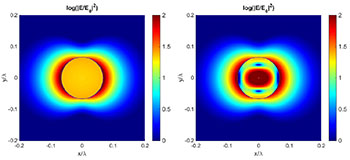The French team’s calculations suggest that plasmonic electric-field intensity amplification of a silver nanoparticle of permittivity –2.5 + i0.5 (left) can be mimicked non-plasmonically by a dielectric particle of permittivity 111.815 + i0.464 (right). [Image: A. Devilez et al., arXiv:1506.09180] [Enlarge image]
In recent years, researchers have made steady progress in applications and techniques that rely on plasmonics—the useful concentration of energy available when light excites local, subwavelength oscillations at conductive metallic surfaces. Now, a group of French scientists reports, in a theoretical study, that field enhancements identical to plasmonic ones should also be available in, of all places, insulators—albeit through a very different mechanism (Phys. Rev. B, doi: 10.1103/PhysRevB.92.241412).
According to the team’s leader, Nicolas Bonod of the CNRS Fresnel Institute, Marseille, France, the finding challenges some textbook assumptions on the requirements for plasmonic-style field enhancement. It also raises some interesting possibilities for new devices, and for extending plasmonic-like effects into the realm of hyperfrequency domains.
Going beyond metals
Plasmonic effects happen when photons striking a metal excite free electrons at the metal surface, forming a surface plasmon polariton—an infrared or visible-frequency electromagnetic wave, shorter than the wavelength of the incident photons, that travels along a metal-dielectric interface. Researchers have lately made considerable progress in fashioning metasurfaces with tiny metallic nanoantennas to emphasize and exploit nanoscale plasmonic effects (see “Plasmonic Nanoantennas,” Optics & Photonics News, June 2015). There have also been some successful efforts to extend plasmonic concentration into doped semiconductors, oxides, and transition-metal nitrides.
Dielectrics, or insulators, would seem to be very poor candidates for any kind of plasmonics—since, by definition, they lack electrons in the conduction band. High-refractive-index dielectrics do, however, sport a different kind of electromagnetic effect called morphology-dependent or Mie resonances, which have been used in some applications.
Modeling nanospheres
Bonod and his team wanted to find out if Mie resonances in dielectrics could be pressed into service to create the kind of subwavelength field enhancements commonly associated with plamonic effects in metals. To do so, they mathematically modeled a spherical nanoparticle to derive a simple mathematical expression that related the permittivities of dielectric and metallic particles that would yield identical electromagnetic responses.
They then ran numerical experiments that confirmed the effect. In one run, they found that the plasmonic enhancement in a silver nanoparticle of permittivity –2.5 + i0.5 could be identically mimicked by a dielectric sphere with a positive permittivity of 111.815 + i0.464. But the source of the effect was totally different between the particles: the electric field within the modeled metallic particle is constant, with the (plasmonic) field enhancement taking place only at the surface, while the field within the dielectric particle shows a complex, churning internal intensity distribution that gives rise to the same external field intensity pattern seen with the metal sphere.
Textbook revision ahead?
Bonod sees both fundamental and practical implications for the work. “It is taught in all textbooks,” he noted in an e-mail, that subwavelength plasmonic effects derive from collective oscillations of free electrons, and that those interactions are unique in their ability to provide subwavelength-scale field enhancements. “We demonstrate,” he says, that “dielectric materials, without free electrons, can achieve the same field enhancements”—and, indeed, that two particles of the same size (relative to the incident-light wavelength), but radically different materials, can provide the same optical response.
In terms of applications, Bonod notes that high-refractive-index dielectrics are “abundant, cost-effective, and easy to manipulate,” and that plasmonic-like effects in such materials could find use in gas sensors, absorbers, and even some applications in MRI systems. And those materials offer some opportunities to extend plasmonic-style field enhancements, which have been limited mainly to the near-infrared and visible frequency bands, to hyperfrequency ranges beyond the visible.

